As the ongoing pandemic continues to push consumers to shop online and get delivery directly to their homes in a bid to stay safe from the spread of Covid-19, online marketplaces are booming as a result. With consumers spending more than $860 billion with United States merchants alone in 2020, there is no doubt that the global economy is shifting ever faster towards global e-commerce as the main way to shop. If you are a business looking to get into the online marketplace industry, it is important to choose the right monetization strategy that meets your purposes, aligns with your customers, and churns out a profit.
1. The Commission Model
The first business model on our list is the commission model because it is widely used across hundreds of product marketplaces. While rarely used by service marketplaces, the commission model works really well by charging a small percentage on each transaction that passes through the marketplace. This percentage can be charged to the seller, to the buyer, or to both parties.
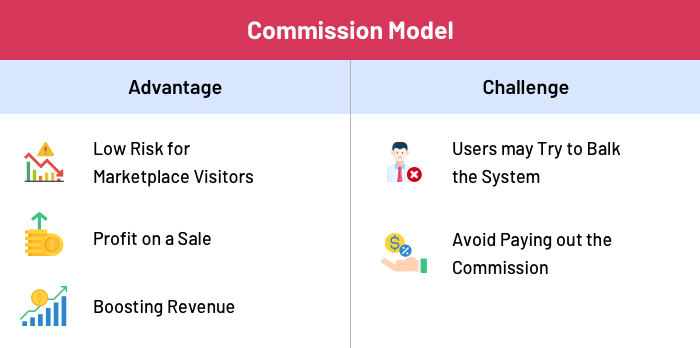
Advantages
The advantage with this model is that visitors who use the marketplace don’t risk themselves and their money without getting anything in return, as they will either make a purchase or profit on a sale. The marketplace itself wins as it gets a bite out of every transaction that takes place, boosting revenue.
Challenges
The potential downside to this model is that users may try to balk the system and avoid paying out the commission. They may try to buy directly from vendors and use the marketplace to farm the contact information instead. Adding on additional value-added services like tracking and insurance can help deter users from trying to avoid the commission.
Examples
Common examples of prominent marketplaces that use the commission based model include Amazon, Etsy, and eBay to garner revenue.
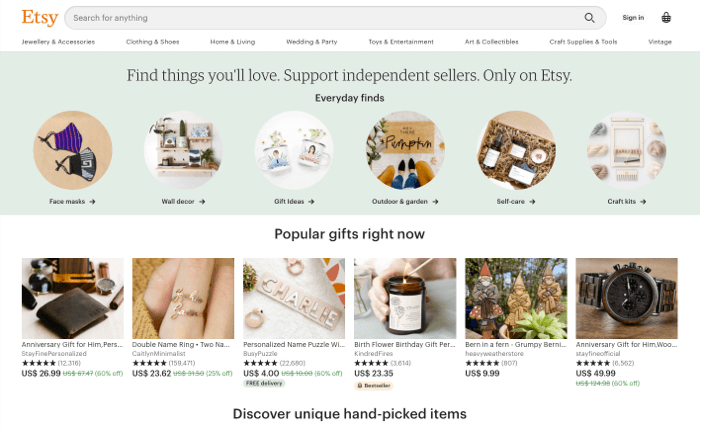
2. The Subscription Model
The second business model on our list is the subscription model which charges users a subscription or recurring fee to access and use the marketplace. This recurring fee is often called a membership plan and is paid by merchants and customers. Many marketplaces that use the subscription based model will offer tiers or levels to make it more attractive to buyers and sellers.
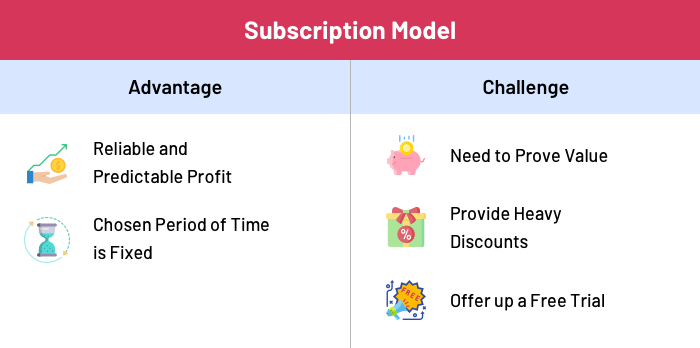
Advantages
The advantage with this model is that it gives you a reliable and predictable way to determine your profit over a chosen period of time. However, if membership plans or tiers aren’t balanced, this can cause some customers to look elsewhere if the levels are too high and if they are too low, you lose out on profit.
Challenges
The challenge here is to prove to your customers that they can get value out of the marketplace. This requires you to have a good reputation, provide heavy discounts for newcomers, or offer up a free trial.
Examples

3. Lead Fees on Users.
The third one on our list may be a bit more obscure in that it tends to be used in service-based marketplaces or contract-based marketplaces such as business-to-consumer or business-to-business relationships. With the lead fee model, users are charged a commission percentage for each lead provided or for each lead that converts. A lead can be anything that leads to a qualified interaction such as a website visit, consultation call, or email inquiry.
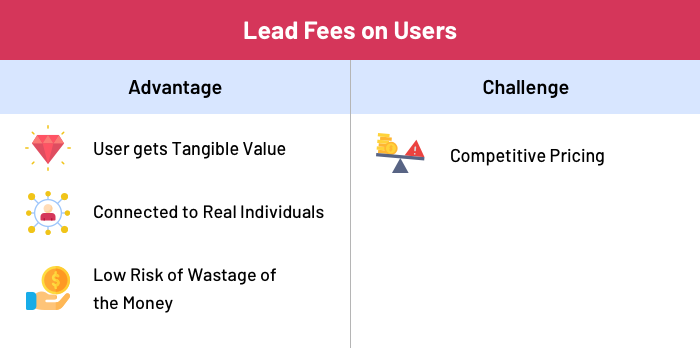
Advantages
The advantage with this model is that the user who pays the fee, gets tangible and immediate value since they are connected to real individuals looking to make a purchase or close a deal. There is less risk here that money will be wasted on unqualified leads, advertising, or dead-ends.
Challenges
The challenge with this model is that you must have competitive pricing that is high enough to warrant the direct connection between supplier and buyer.
Examples

An example of a business that uses the lead fee model is Thumbtack. This is a company that charges a fee to connect customers with local specialists.
4. Listing Fee Monetization
Our fourth model on the list is, listing fee monetization. With this approach, providers are charged a fee to post a listing. The great thing about this model is that it is flexible, and allows you to charge your vendors for listings in certain categories, while making others free to post in. The listing fee may be a flat rate for each posting or it may be a percentage of the value of the goods or services being sold.
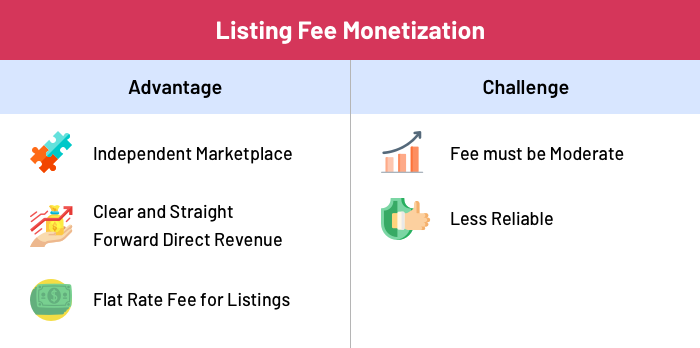
Advantage
The advantage of this model is that the marketplace does not rely on the seller’s ability to be profitable. Your revenue directly comes from a clear and straightforward percentage or flat rate fee for listings in certain categories.
Challenges
The challenge is that the fee can’t be too high, so this model may need to be supplemented with another to boost profit margins. The listing fee model works well if you have a marketplace that is constantly getting new leads and listings.
Examples

The most popular example of this is Craigslist & Kijiji which charges fees to post listings in particular categories such as: services or job listings.
5. Using Featured Listings & Advertisements
The fifth model in our list is featured listings & advertisements, which give vendors using the marketplace more exposure either of their own profiles or of their products. In most cases, featured listings are included on the main page and may include sponsored products.
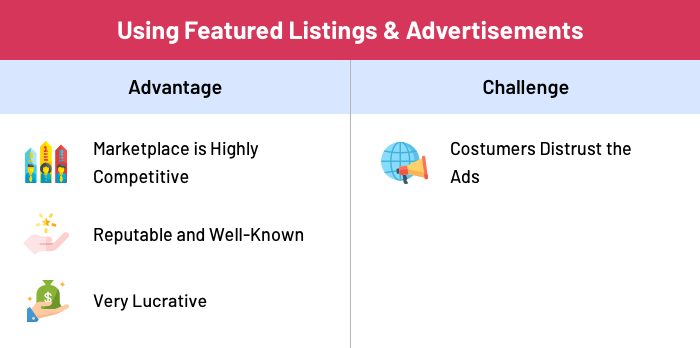
Advantages
The advantage of this model is the marketplace is highly competitive, reputable and well-known. This can be a very lucrative business model to employ.
Challenges
The challenge with this is that consumers are very distrusting of advertisements, so trying to get them to purchase a certain product or service is daunting if it is done all through ads. Any featured listings that are done should be high-quality, unintrusive, and of high-quality items.
Examples
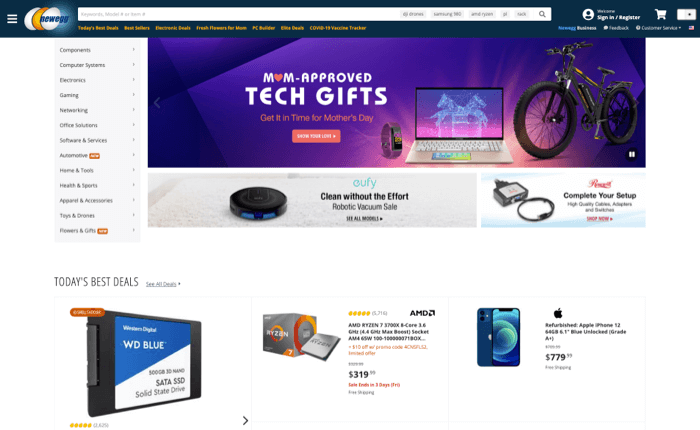
Marketplaces like Newegg, Amazon, and Fiverr use this model as an additional way to make a profit.
6. The Freemium Model
The sixth and final model on our list is one you’ve probably come across as a user yourself; the freemium. It offers up a free tier or plan to all members and then upsells additional features for a fee. The idea here is to get those interested in your marketplace to get hooked by the basic services being offered and then upsell them the benefits that come with the additional services.
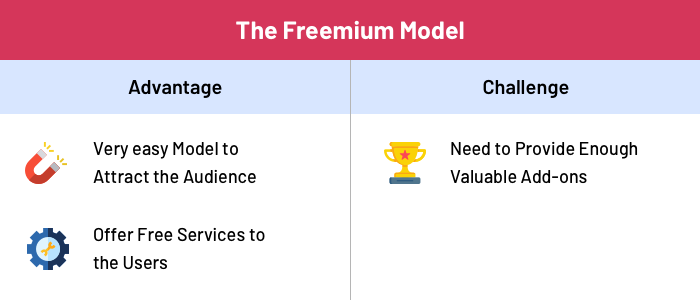
Advantages
The advantage with this business model is that it is a lot easier to attract an audience to your marketplace, as people like to use services for free.
Challenges
But the challenge comes in trying to provide enough valuable add-ons to make it worth the price to users to upgrade their plan. This model works well if you are going to pair it with featured listings, advertisements, or listing fees, but on its own, it isn’t the strongest option.
Examples
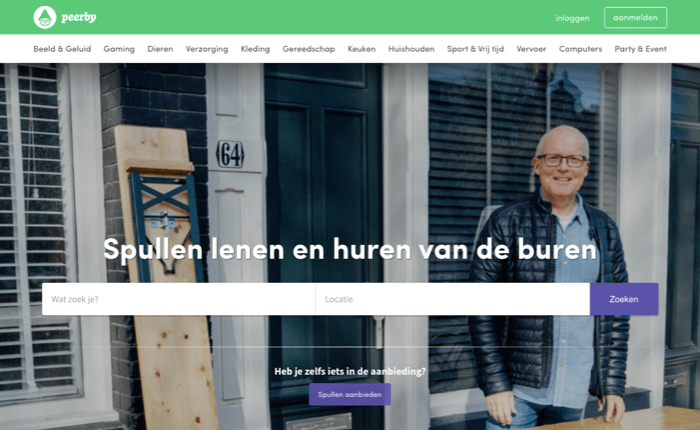
One of the Dutch startups called Peerby comes under this model. It’s basically free, but it has two paid offerings: insurance and delivery. They have basically two main offerings: Insurance and delivery.
Conclusion
If you are thinking about opening up a marketplace platform, the best course of action is to carefully consider your audience base, what services you are offering on the platform, and what value you can provide. Then combine 1-2 of the models above to create a mixed-revenue model to generate profit while still being able to balance both customers and sellers.
If you want to share your ideas or clear your doubts, contact our experts.






































